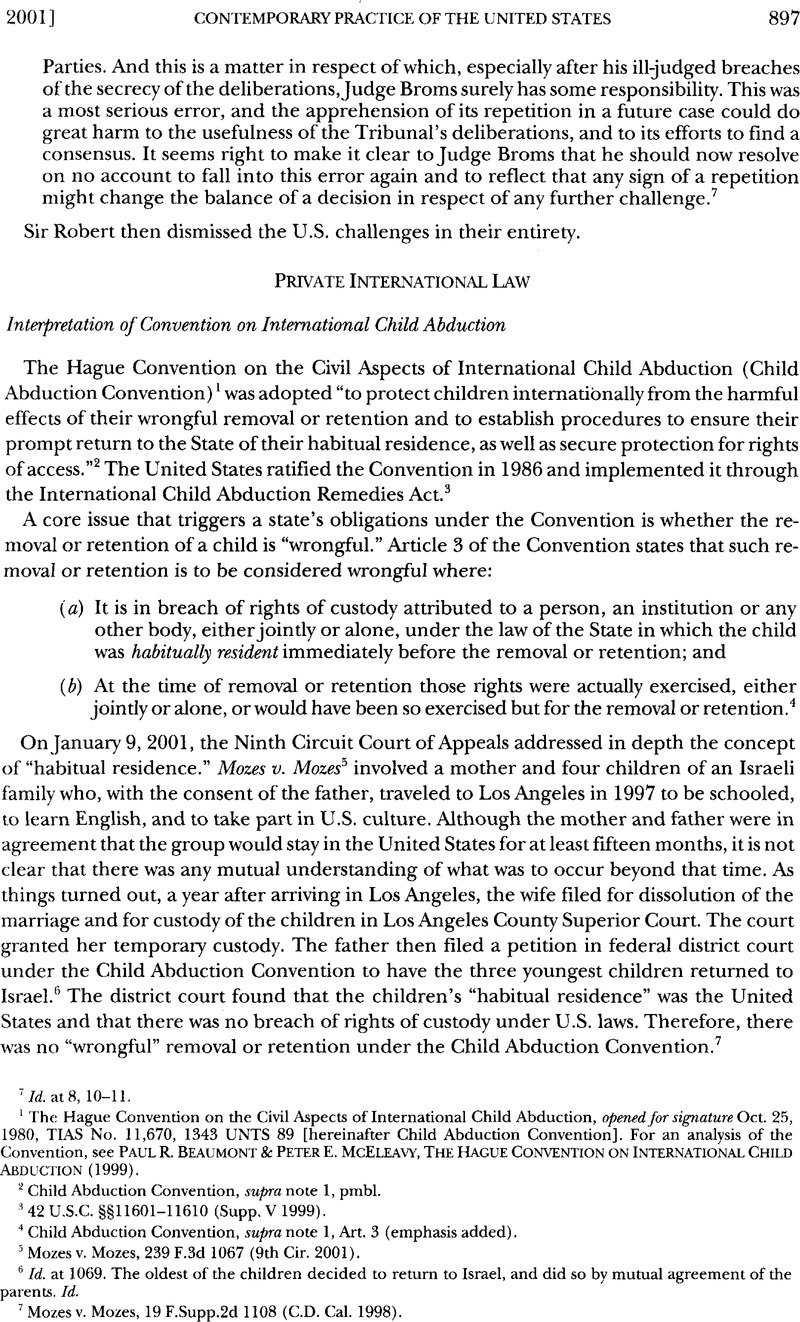No CrossRef data available.
Published online by Cambridge University Press: 10 March 2017

1 The Hague Convention on the Civil Aspects of International Child Abduction, opened for signature Oct. 25, 1980, TIAS No. 11, 670, 1343 UNTS 89 [hereinafter Child Abduction Convention]. For an analysis of the Convention, see Paul, R. Beaumont & Peter, E. Mceleavy, The Hague Convention on International Child Abduction (1999)Google Scholar.
2 Child Abduction Convention, supra note 1, pmbl.
3 42 U.S.C. §§11601–11610 (Supp. V 1999).
4 Child Abduction Convention, supra note 1, Art. 3 (emphasis added).
5 Mozes v. Mozes, 239 F.3d 1067 (9th Cir. 2001).
6 Id. at 1069. The oldest of the children decided to return to Israel, and did so by mutual agreement of the parents. Id.
7 Mozes v. Mozes, 19 F.Supp.2d 1108 (CD. Cal. 1998).
8 239 F.3d at 1071 (quoting C v. S, [1990] 2 All E.R. 961, 965 (H.L.)).
9 Id. at 1072.
10 Id. at 1073–74, 1076, 1081. “Habitual residence is intended to be a description of a factual state of affairs, and a child can lose its habitual attachment to a place even without a parent’s consent.” Id. at 1081.
11 Id. at 1084.
12 See 42 U.S.C. §11603(e)(2)(A), (B); see also Child Abduction Convention, supra note 1, Arts. 12, 13(b), 20.
13 Child Abduction Convention, supra note 1, Art. 13(b).
14 Blondin v. Dubois, 19 F.Supp.2d 123 (S.D.N.Y. 1998). The Second Circuit Court of Appeals vacated this initial decision and remanded the case for further proceedings, asking the district court to determine whether any arrangements might be made that would mitigate the risk of harm to the children from repatriation. Blondin v. Dubois, 189 F.3d 240 (2d Cir. 1999). The district court then found that return to France under any circumstances would cause the children psychological harm. Blondin v. Dubois, 78 F.Supp.2d 283, 297 (S.D.N.Y. 2000).
15 Blondin v. Dubois, 238 F.3d 153, 155 (2d Cir. 2001).
16 Id. at 162.
17 Id. (quoting Friedrich v. Friedrich 78 F.3d 1060, 1069 (6th Cir. 1996)).
18 Id. at 160–61.
19 Id. at 166; see Child Abduction Convention, supra note 1, Art. 13.
20 234 F.3d 268, 270 (5th Cir. 2000).
21 Id. at 272. For other recent cases dealing with the exceptions to repatriation, see March v. March, 2001 U.S. App. LEXIS 7110 (6th Cir. Apr. 19, 2001); Bekier v. Bekier, 248 F.3d 1051 (11 th Cir. 2001); Pesin v. Rodriguez, 244 F.3d 1250 (11th Cir. 2001) (precluding consideration of the matter under the fugitive disentitlement doctrine); Miller v. Miller, 240 F.3d 392 (4th Cir. 2001); Dorinou v. Mezitis, 237 F.3d 133 (2d Cir. 2001); Tsarbopoulos v. Tsarbopoulos, 2000 WL 1721800 (9th Cir. Nov. 17, 2000); Kanth v. Kanth, 2000 WL 1644099 (10th Cir. Nov. 2, 2000); Whallon v. Lynn, 230 F.3d 450 (1st Cir. 2000); Croll v. Croll, 229 F.3d 133 (2d Cir. 2000); Walsh v. Walsh, 221 F.3d204 (1st Cir. 2000); Toren v. Toren, 191 F.3d 23 (1st Cir. 1999); Shalitv. Coppe, 182F.3dll24 (9th Cir. 1999).